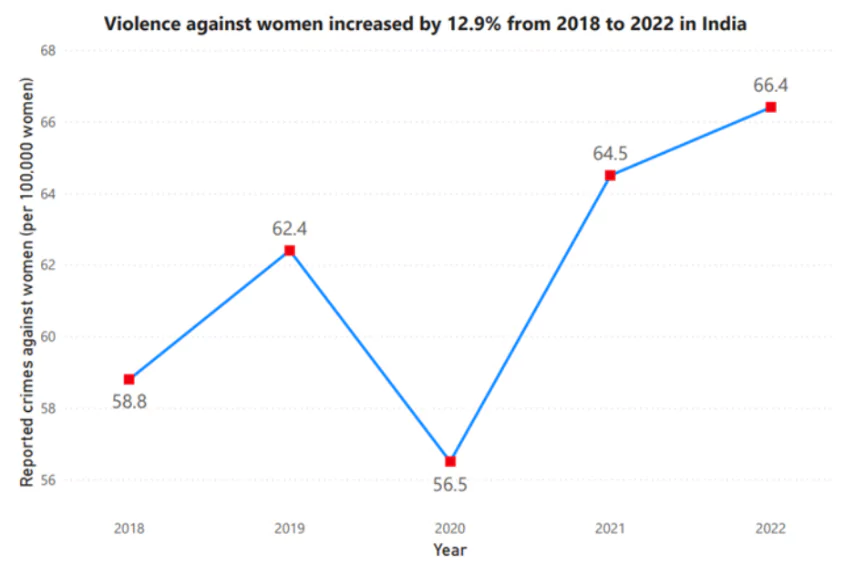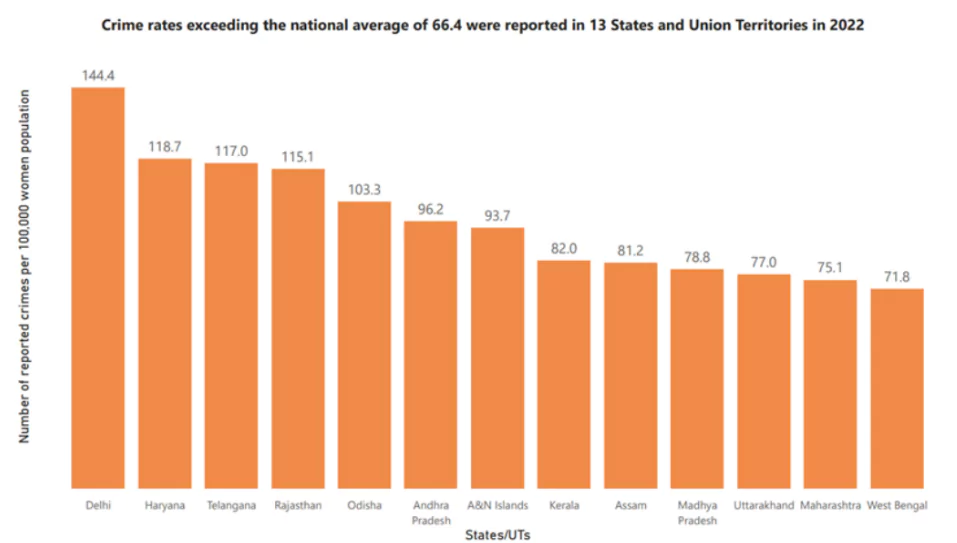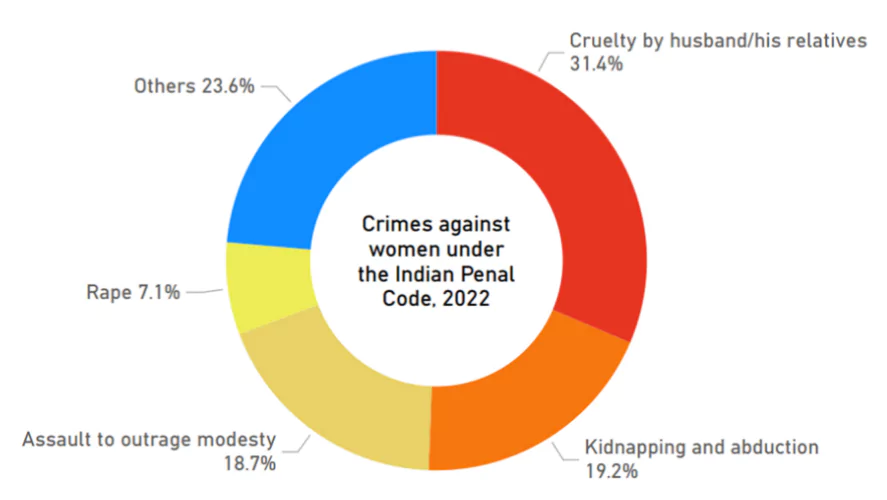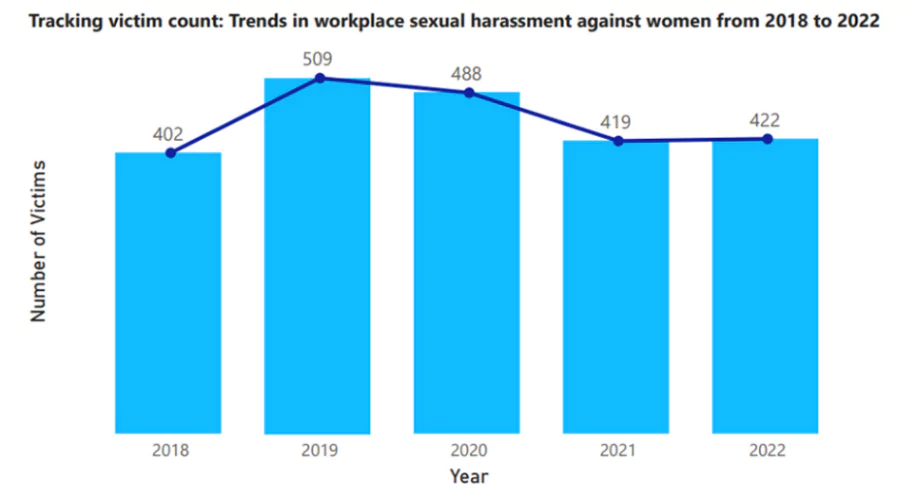The recent rape and murder of a doctor in Kolkata has once again highlighted the brutal atrocities against women, even in 21st century India.
“The day a woman can walk freely on the roads at night, that day we can say that India has achieved independence”. Mahatma Gandhi.
Statistics On Crimes Against Women
- As per the Women Peace and Security Index 2023 released by Georgetown Institute for Women, Peace and Security: India ranks 128 out of 177 countries in terms of women’s inclusion, justice, and security.
 Data from the National Crime Records Bureau (NCRB) Reveals:
Data from the National Crime Records Bureau (NCRB) Reveals:
- Increase in numbers: Crimes against women in India (calculated as crimes per 100,000 of the women population) increased by 12.9% between 2018 and 2022.
- In India, the reported crimes against women per 100,000 women population is 66.4 in 2022, in comparison with 58.8 in 2018.
- Reason: This increase could be due to a number of factors, including an increase in actual crimes, an improvement in reporting mechanisms, and a growing willingness of women to speak out about their experiences of violence.
- State Wise Data:
 Statistics in “Crime in India 2022”, the annual report by NCRB, show that a total of 13 States and Union Territories recorded crime rates higher than the national average of 66.4.
Statistics in “Crime in India 2022”, the annual report by NCRB, show that a total of 13 States and Union Territories recorded crime rates higher than the national average of 66.4. - Delhi topped the list at 144.4 ,followed by Haryana (118.7), Telangana (117), Rajasthan (115.1) and Odisha (103.3)
- The rate of crime in Uttar Pradesh which contributed nearly 15 percent of the cases in India stood at 58.6.
- Categorized of Crime Against Women:
- Majority of crimes against women were categorized as cruelty by the husband or his relatives (31.4%)
- It’s followed by kidnapping and abduction (19.2%), assault with intent to outrage modesty (18.7%), and rape (7.1%).

Enroll now for UPSC Online Course
Global Figures
- Violence Against Women and Girls (VAWG) is a serious and pervasive issue.
- According to the World Health Organization: At least one in three women worldwide has experienced physical or sexual violence in their lifetime
- Nearly one in 10 girls has experienced forced intercourse or other sexual acts.
|
Reasons Behind Lack Of Women Safety In India
- Economic independence: A lack of economic independence further cripples women’s ability to protect themselves from abuse and harassment.
- Share in Property: Despite legal frameworks, most women are not entitled to a share in property, due to established social norms.
- Disproportionate Representation: Men are disproportionately represented in government and corporate positions of power.
- This makes it an uphill battle and a missed opportunity to acknowledge the value that women contribute to business.
- The female contribution to GDP is 18 per cent, one of the lowest in the world, reflecting the fact that women make up only 25 per cent of the labour force.
 Women’s participation in the labour force: It is mostly in the informal economy, which gives them little access to social protection.
Women’s participation in the labour force: It is mostly in the informal economy, which gives them little access to social protection.-
- Workplace Violence: In the workplace too, women face a higher risk of gender violence.
- POSH Act: Despite the existence of the Sexual Harassment of Women at Workplace Act, 2013 (commonly known as POSH Act).
- As per NCRB, the victim count for workplace sexual harassment against women has increased from 402 in 2018 to 422 in 2022.
- Concerning: This is cause for concern, because it is well-established that women actually under-report crimes against them due to fear of repercussions, inadequate awareness, and societal biases.
- Cultural Norms and Misogyny: Misogyny, which refers to the hatred of or prejudice against women, is prevalent in many societies where women are objectified and devalued.
- For instance, consider ads for products like washing powder, where only women are shown, or how boys are discouraged from playing with dolls and told to “be a man,” reinforcing the idea that only girls play with dolls creates a prejudice.
- Cultural norms that promote male superiority, victim-blaming, and the sexualization of women contribute to a mindset that justifies or normalizes sexual violence against women.
- There are instances where rape victims are trolled for speaking out, with comments like “a clap never happens with a single hand” or “she might have been wearing short dresses, roaming out alone,” which blame the victim instead of addressing the crime.
- Weak Legal Systems and Impunity:
- A significant factor in the prevalence of crimes like rape is the weakness of the legal system in dealing with sexual crimes.
- When perpetrators believe they will not face serious consequences, they are more likely to commit such acts.
- The failure to swiftly prosecute and punish rapists creates a culture of impunity. Therefore, laws must be designed to create a deterrent effect, instilling fear among potential wrongdoers.
- Patriarchy and Gender Inequality: Crimes like Rape is deeply rooted in patriarchal structures where men are often seen as dominant over women.
- This inequality perpetuates the idea that women are subordinate and can be controlled or violated. Men begin to see themselves as superior.
- The social conditioning of men to assert dominance over women can lead to violent expressions of power, such as rape
- Inadequate safety in public places: Inadequacies in public infrastructure, such as poorly lit streets, lack of safe transportation options, lack of CCTVs, increase vulnerability of women to crime.
- For example: Nirbhaya Rape in a public transportation and Kolkata rape in a public hospital highlights the lack of public safe spaces for women.
Various Special Laws Relating To Women Safety In India, Includes
- Protection of Women from Domestic Violence Act, 2005
- Dowry Prohibition Act, 1961
- Indecent Representation of Women (Prohibition) Act, 1986
- Sexual Harassment of Women at Workplace (Prevention, Prohibition and Redressal) Act, 2013
- Prohibition of Child Marriage Act, 2006
- Juvenile Justice (care and protection of children) Act, 2015
- Commissions for Protection of Child Rights Act, 2005
- Protection of Children from Sexual Offences Act, 2012
- Commission of Sati (Prevention) Act, 1987.
Check Out UPSC CSE Books From PW Store
More Details on Laws
- Dowry Death and Procedural Laws:
- Section 174 of the Code of Criminal Procedure, 1973 is amended to secure medical examination in case of suicide or death of woman within seven years of her marriage.
- Section 113-A has been introduced in the Evidence Act, 1872.
- It states that if the wife commits suicide within a period of seven years of her marriage, it will be presumed that she had been subjected to cruelty by her husband and his relatives as per sec.498- A, IPC
- Acid Attacks
- Section 326 of the Indian Penal Code was amended on 2nd April, 2013 with the passing of the Criminal Laws (Amendment) Act, 2013.
- The amendment resulted in insertion of sections 326-A and 326-B for specifically dealing with acid violence.
- Sexual Harassment And Outraging The Modesty Of A Women
- Modesty in section 354 IPC is an attribute associated with women.
- Modesty: The act of using force on a woman (such as removing her clothes) with intent to assault her sexually is considered to be an act of outraging her modesty.
- Punishment: The punishment is of at least one year which may extend to five years.
- Sexual assault and Rape:
- It involves a perpetrator physically forcing a sexual act on a woman.
- Section 375, 376, 376 A-D of Indian Penal Code deals with Rape
- Domestic Violence
- Protection of Women from Domestic Violence Act, 2005 (PWDVA) recognizes a life free of violence and fear and makes the state responsible for extending protection against domestic violence to women
- Honor killing or shame killing:
- It is the homicide of a member of a family by other members, due to the perpetrators’ belief that the victim has brought shame or dishonor upon the family
- Or they believe that it has violated the principles of a community or a religion, usually for reasons such as
- Refusing to enter an arranged marriage
- Being in a relationship that is disapproved by their family
- Having sex outside marriage
- Becoming the victim of rape
- Dressing in ways which are deemed inappropriate
- Engaging in non-heterosexual relations or renouncing a faith.
|
Challenges In Ensuring The Same Intention And Outcome Of The Women Safety Laws
- Liberal Bail Regime: A liberal bail regime cannot be sustained independent of other judicial reform.
- Dowry Death: Of the 3,449 cases of dowry death cases disposed off by the courts in 2022, 64 per cent were disposed of without a trial and only 35 per cent of the tried cases resulted in a conviction.
- Of the staggering 85,2598 cases of cruelty by husbands pending trial, a mere 7.7 per cent were disposed of, of which 87 per cent were disposed of without a trial.
- Larger failure is the chasm between intention and outcome:
- Promises made in the aftermath of the horrific gangrape incident in 2012 have largely been reduced to lip service
- Allocation of Funds: The 100 per cent increase in the budgetary allocation of the Nirbhaya Fund for 2024-25 could be appreciable.
- Fund Used: But, data shows that between 2013 (when it was set up) and 2022, less than half of the allocation had been used.
- Half-hearted implementation of Act: It has been found that the implementation of the Sexual Harassment of Women at Workplace (Prevention, Prohibition, Redressal) Act, notified in 2013, has been half-hearted.
- In May 2023, the Supreme Court called out “authorities/management/employers” for failing to ensure a “safe and secure workplace” for women.
- Backlogged and Delayed Justice: India’s judicial system is notoriously backlogged and cases can take years to go through the courts.
- For many women, this adds to the stigma of reporting a rape or sexual assault, because of the long delay they face to get any form of justice.
- Police Force: The largely male police force also needs to change – women make up just under 11 per cent, far behind the UK, where female officers constitute a third of overall law enforcement.
- In 2022: India Justice Report, which surveys the state of law enforcement, said it would take 24 years to reach the police’s target of 33 per cent female representation.
- Ignoring Verma Committee Recommendation: The Verma Committee, which was formed after the December 2012 gangrape in Delhi, had recommended making command responsibility liable to prosecution, especially when states ignore their duty to prevent mass scale sexual violence.
- The BNS also ignored the serious recommendations to redress and prevent sexual violence made repeatedly by autonomous women’s movements.
Check Out UPSC NCERT Textbooks From PW Store
Government Initiatives
- Financial Empowerment: Women’s empowerment is contingent upon the economic empowerment of women. That is why the government has taken steps to promote financial inclusion among women .
- Stand-Up India scheme: It focuses on providing support for the establishment of greenfield enterprises among women, Scheduled Castes (SC), and Scheduled Tribes (ST).
- Pradhan Mantri Mudra Yojana: PMMY aims to provide financial assistance to non-corporate, non-farm micro and small enterprises.
- Around 69% of the loans have been sanctioned to women entrepreneurs under PMMY and 84% of the beneficiaries under Stand-Up India are women.
- Mahila Samman Savings Certificate: It was introduced as part of the Union Budget 2023-24, which is a small savings scheme exclusively for female investors.
- These initiatives have enabled women to chart their paths and contribute to the economic growth of the nation.
- Safety and Security
- Mission Shakti: It is another noteworthy endeavour by the government, seeking to enhance women’s safety, empowerment, and participation in the workforce.
- Mission Shakti has created an enabling environment for women to thrive and actively contribute to society.
- AIM: This mission aims to address gender biases, discrimination, and the care burden on women through skill development, capacity building, financial literacy, and access to micro-credit.
- One-Stop Centres (OSCs): Integrated services provided under one roof, such as police, medical and legal aid, counselling, and psycho-social support through One-Stop Centres (OSCs), ensure comprehensive assistance for women affected by violence.
- A toll-free women’s helpline (181) further offers emergency and non-emergency support.
- Working Women Hostel: The objective of the scheme is to promote availability of safe and conveniently located accommodation for working women
- With day care facility for their children,wherever possible, in urban, semi urban, or even rural areas where employment opportunity for women exist.
- Community Policing Models: Initiatives like the Pink Patrol in Jaipur involve women police officers patrolling public spaces to enhance visibility and address safety concerns
- Investigation Tracking System for Sexual Offenses: MHA has launched it to monitor and track time-bound investigation in sexual assault cases in accordance with Criminal Law (Amendment) Act 2018.
- Meri Saheli Intiative: Launched by the railway Protection force, this intiative ensures security of lady passengers that are traveling by train by a dedicated Mahila officers team.
- Dignity of livelihood
- PM Awas Yojana – Gramin: Recognizing the importance of secure housing and financial decision-making for women
- PM Ujjwala Yojana: To address the health and safety concerns of women, the Pradhan Mantri Ujjwala Yojana (PMUY) was launched in May 2016.
- This initiative aims to provide clean cooking fuel, (LPG), to rural and underprivileged households.
- Nari Shakti Adhiniyam – Amrit Peedi’s Moment:
- A milestone in this journey has been achieved by the passing of the Nari Shakti Vandan Adhiniyam, 2023) which seeks to reserve one-third of the total number of seats for women in Lok Sabha, State Legislative Assemblies and Delhi Assembly.
- Beti Bachao, Beti Padhao – A step towards gender empowerment:
-
- One of the key initiatives is the BBBP scheme, which has generated significant mass mobilization to combat gender discrimination and promote the value of the girl child.
- At every level, the scheme has worked diligently to raise awareness about the rights of girl children through community engagement.
- By advocating against sex selection at birth and encouraging positive action to support their educational growth, BBBP has brought about a positive change.
Way Forward
We need a systemic change, which can only happen through a multi-faceted approach:
- Reforming Policy And Law:
- Review the complete spectrum of crimes against Women:
- A serious legal response to women’s safety must entail a review of the complete spectrum of crimes against them in order to truly inculcate society’s intolerance to any form of abuse.
- Graded penal provisions are required depending on the severity of the crime.
- Forcibly disrobing a woman or stubbornly stalking her with the intention of committing sexual assault cannot be dealt at par with milder versions of “harassment”.
- The victim must not be made to wait for the potent penal sections to kick in till she is raped.
- Fast-track mode Trials: There is a crying need to develop a criminal justice system equipped to investigate and try cases of crimes against women in a fast-track mode.
- Harder Punishment: When court cases drag on for a long time, the only way to make people fear the law is to keep them in jail for a long period, depending on how serious the crime is.
- No extra judicial compromises must be ensured: Courts need to take strong action against extra judicial compromises that are forced on victims due to the lengthy legal process or because society accepts such deals.
- Education: Gender-transformative approaches can be implemented via childhood education and household- and community-level interventions.
- Innovative methods: Such as gameplay can be used to involve both men and women in gender equality initiatives.
- Raising Awareness: Civil societies, SPOs, ASHA workers, SHGs, religious/faith-based institutions, and government initiatives can also play a vital role in raising awareness about gender-based violence through social gatherings and networking sites.
- These entities can raise awareness through educational campaigns, community outreach, and media engagement.
- They operate by organising workshops, leveraging social media, and collaborating to address gender-based violence and promote a culture of respect and equality.
- Other Methods include changing cultural attitudes, reforming policy and law, increasing support services for survivors, and conducting more information campaigns, workshops, and training programmes, and designing intervention programmes based on data.
Enroll now for UPSC Online Classes
Conclusion
People power has brought attention to the plight of women in India. But that is no longer enough. For meaningful change, policymakers need to reform the institutions that can directly improve the lives of half the population. Women in the world’s largest democracy deserve that.
![]() 24 Aug 2024
24 Aug 2024
 Data from the National Crime Records Bureau (NCRB) Reveals:
Data from the National Crime Records Bureau (NCRB) Reveals:
 Statistics in “Crime in India 2022”, the annual report by NCRB, show that a total of 13 States and Union Territories recorded crime rates higher than the national average of 66.4.
Statistics in “Crime in India 2022”, the annual report by NCRB, show that a total of 13 States and Union Territories recorded crime rates higher than the national average of 66.4. 
 Women’s participation in the labour force: It is mostly in the informal economy, which gives them little access to social protection.
Women’s participation in the labour force: It is mostly in the informal economy, which gives them little access to social protection.